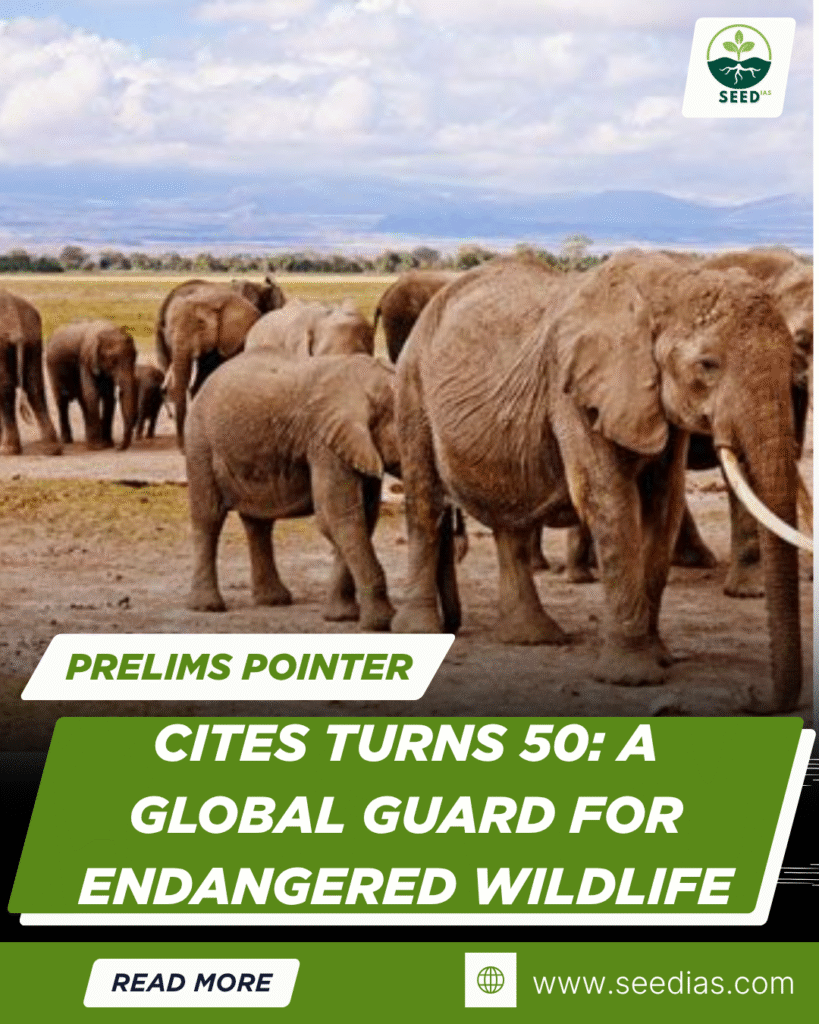Why in NEWS
The Convention on International Trade in Endangered Species of Wild Fauna and Flora (CITES) completed 50 years on 1st July 2025, renewing focus on wildlife conservation, sustainable trade, and global environmental cooperation.
What is CITES?
| Aspect | Details |
|---|---|
| Full Name | Convention on International Trade in Endangered Species of Wild Fauna and Flora |
| Also Known As | Washington Convention |
| Signed | 3rd March 1973 |
| Came into Force | 1st July 1975 |
| Members | 185 parties including India (since 1976) and the EU |
| Administered By | UN Environment Programme (UNEP), Geneva |
| Aim | To ensure that international trade in wild animals and plants is legal, sustainable, and traceable |
How Does CITES Work?
| Mechanism | Description |
|---|---|
| Permit System | Export, import, re-export, and introduction from the sea require permits issued by national authorities. |
| National Bodies | Each member appoints a Management Authority (handles permits) and a Scientific Authority (gives advice). |
| CITES Trade Database | Tracks global legal wildlife trade, aiding transparency and enforcement. |
CITES Appendices Explained
| Appendix | Species Status | Trade Status |
|---|---|---|
| Appendix I | Threatened with extinction | Trade permitted only in exceptional circumstances |
| Appendix II | Not currently threatened but could be | Trade controlled to avoid risk |
| Appendix III | Protected by one country seeking support | Trade regulated through cooperation |
Significance of CITES
| Area | Contribution |
|---|---|
| Wildlife Protection | Covers 40,000+ species including African elephants, rhinos, tigers, and pangolins |
| Poaching Reduction | MIKE Programme monitors and curbs illegal killing of elephants in Africa & Asia |
| Legal Framework in India | All CITES-listed species now included in Schedule IV of the Wild Life (Protection) Amendment Act, 2022 |
| Global Partnerships | Collaborates with FAO (fisheries), ESCAP (capacity building), UNDP (youth & conservation) |
Why is CITES Still Relevant?
| Reason | Explanation |
|---|---|
| Biodiversity Crisis | Wildlife trade, habitat loss, and climate change continue to threaten species. |
| Illegal Wildlife Trade | Worth billions annually, it undermines conservation and fuels criminal networks. |
| Sustainable Development Goals | CITES supports SDGs on biodiversity (15), sustainable consumption (12), and poverty reduction (1). |
Conclusion
At 50, CITES remains a cornerstone of global environmental governance, balancing ecological sustainability with economic needs. Strengthening its enforcement, expanding cooperation, and modernizing its digital monitoring will be key to securing wildlife futures in the Anthropocene.
In a Nutshell – Use Code “CITES50”
C – Controls on wildlife trade
I – International cooperation
T – Threatened species protection
E – Enforced via permits
S – Sustainable and legal trade
5 – Five decades of impact
0 – Zero tolerance for illegal trade
Prelims Practice Questions
- Which of the following best describes the aim of the CITES Convention?
A) Protection of marine fisheries only
B) Control of chemical waste trade
C) Regulating international trade in endangered species
D) Promoting free global trade in wildlife - Appendix I of CITES includes species that are:
A) Domesticated and farmed globally
B) Not threatened but require monitoring
C) Threatened with extinction and trade is highly restricted
D) Threatened but trade is freely allowed - CITES is administered by which of the following agencies?
A) UNDP
B) UNEP
C) IUCN
D) UNESCO
Mains Practice Questions
- Discuss the role of CITES in global wildlife conservation. How does it complement national legislation like India’s Wildlife (Protection) Act? (GS – 3)
- Examine the challenges faced by international treaties like CITES in tackling illegal wildlife trade. Suggest strategies for stronger global enforcement. (GS – 3)
Answer Key – Prelims
| Qn | Answer | Explanation |
|---|---|---|
| 1 | C | CITES regulates international trade in endangered species. |
| 2 | C | Appendix I species are the most threatened and trade is strictly limited. |
| 3 | B | CITES is administered by the UN Environment Programme (UNEP). |
















